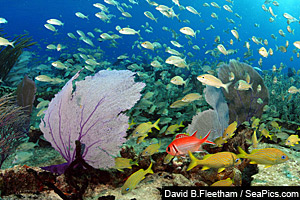Settling Ownership of the Bounty of the High Seas
 Many ocean species that are over-exploited and traded internationally live in areas beyond national jurisdiction, a region known as the high seas that starts 200 miles from shore and covers half the Earth. Fish taken from here frequently end up on dinner tables around the world and in cosmetics and medicines. Under international law, however, animals in these marine areas, which are outside the legal reach of any country, belong to no one -- until they are caught. For the sake of protecting this high seas bounty, we urgently need to settle the key question: to whom do they belong?
Many ocean species that are over-exploited and traded internationally live in areas beyond national jurisdiction, a region known as the high seas that starts 200 miles from shore and covers half the Earth. Fish taken from here frequently end up on dinner tables around the world and in cosmetics and medicines. Under international law, however, animals in these marine areas, which are outside the legal reach of any country, belong to no one -- until they are caught. For the sake of protecting this high seas bounty, we urgently need to settle the key question: to whom do they belong?
The current, simple answer is that no one country is responsible for any species on the high seas. The more complex reply is that a debate over this issue has carried on for decades, with the most recent discussion having been held at a meeting of the Convention on International Trade in Endangered Species (CITES) Standing Committee in Geneva.
Fortunately, the regulation of international trade is already used to help conserve depleted species, and could help to further protect the ocean. CITES, a treaty in effect since 1973, prohibits all international trade among countries of products from certain endangered species, including tigers, gorillas, pandas, and sea turtles, under what are called "Appendix I" rules. For species that are under slightly less threat, CITES member governments may apply a second tier of restrictions. This allows some international trade -- if it is legal and sustainable. The provision, known as "Appendix II," includes species such as monkeys, parrots, alligators, sturgeon, and coral.
On the high seas, however, things get murky. If a high-seas species is on the CITES list, meaning that international trade is either prohibited or regulated, it is unclear which country or countries should take responsibility for permits and other paperwork.
The CITES treaty was negotiated almost 40 years ago, and there is a long history of debate around the issue of who is responsible on the high seas. Some say ensuring compliance is the duty of the port State -- the country where these animals are landed, or "received. " Others say that the flag State -- the country that operates the high-seas fishing vessel -- should be accountable for ensuring proper observance of the rules. Seemingly narrow matters like these can have a large, real-world impact, and governments tackling this issue for many years may be nearing a final decision. After intense debate and scrutiny, CITES is likely to formally adopt a solution at its 2013 Conference in Thailand.
The negotiators suggest that if the fishing vessel lands its catch on its own shores, then it is responsible for issuing documentation and complying with all requirements (so-called "Introduction from the Sea"). If the fishing vessel and port State are two different countries, then the former would issue a CITES export permit. This concept of "Introduction from the Sea" reflects much of the debate concerning governance of the oceans. For countries enjoying the privilege of fishing and harvesting ocean resources, accountability and responsibility should go hand in hand.
At the next meeting of all CITES member countries, governments will once again have the chance to "list" more over-exploited, commercially valuable marine species in the CITES Appendices. The United States and the EU should propose protection for several sharks species enabling international trade regulation. Although these species' populations are seriously depleted, nearly all of them lack any international conservation measures or science-based management.
Despite the recent progress, the question of who governs and owns the high seas and its marine life is likely to pose complex policy and legal dilemmas, as it has for decades. Some countries believe that only regional fisheries management organizations should regulate trade in any species in international waters. Others believe that since those entities have not adequately protected certain species to date (for instance, sharks, many of which are threatened or endangered), other bodies like CITES should step in.
Either way, global governance of the high seas -- which are the "global commons"-- is at the heart of the problem. To ensure the conservation of these ocean ecosystems, we need to work with the full range of fishery management options. Determining which country is responsible for the trade documents may seem like a legal detail, but is an important step in the right direction and the path should be strongly encouraged.











